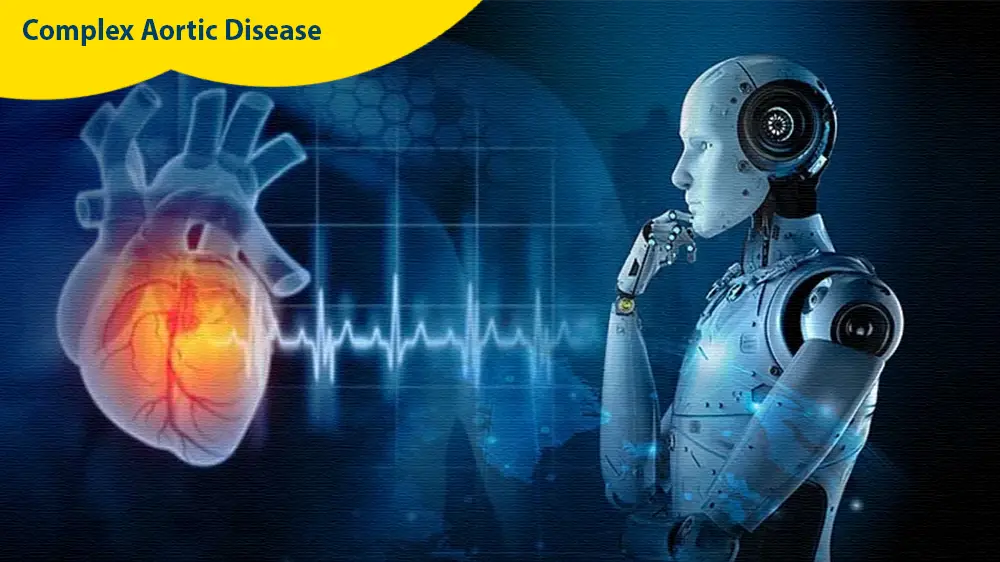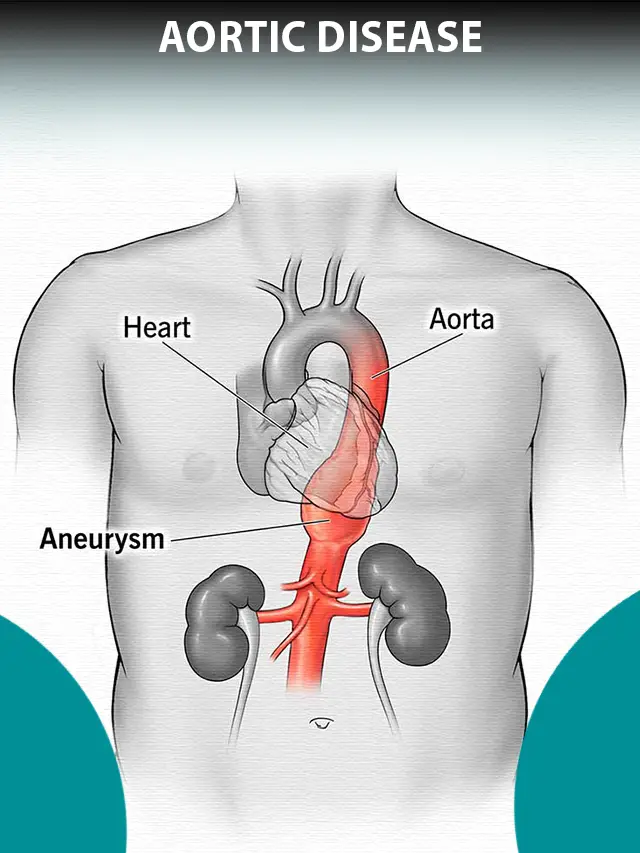
HEALTH BLOG
AI Technology to Treat Complex Aortic Disease and What Is Aortic Disease?
-
 Rahul Priydarss
Rahul Priydarss - February 14, 2024
Discover how AI technology revolutionizes the treatment of complex aortic diseases. Read about the latest advancements in AI-assisted diagnostics, surgical inventions, and patient outcomes. Elaborating what aortic disease is and how innovative AI solutions are shaping the future of cardiac care.
What Is The Aortic Disease:
– The aortic disease includes a spectrum of conditions affecting the aorta, which is the largest artery in the human body that is responsible for carrying oxygenated blood from the heart to the rest of the body. This complex network of blood vessels can be vulnerable to various disease processes, causing abnormalities in its structure and function.
– Aortic disease can range from congenital anomalies to acquired conditions, which present a significant medical challenge due to the potential for serious complications, including life-threatening events such as aortic dissection or rupture.
– The anatomy and physiology of the aorta are important to the variety of disorders that can affect it. The aorta consists of several segments, including the ascending aorta, the aortic arch, and the descending thoracic and abdominal aorta. Each segment may be differently affected by different disease processes, leading to different clinical manifestations and management strategies.

Table of Contents
– While some individuals may inherit a genetic predisposition to aortic diseases, others may develop them due to factors such as high blood pressure, atherosclerosis, connective tissue disorders, or inflammatory conditions. Symptoms of the aortic disease can vary widely depending on the underlying pathology and the location of the affected segment. These may include chest or back pain, shortness of breath, palpitations, or neurological deficits.
Types Of Aortic Disease:
The types of aortic disease can be broadly classified into two main groups: degenerative and genetic/acquired. Degenerative aortic disease usually involves age-related changes in the structure and function of the aorta, while genetic or acquired conditions are often associated with inherited disorders or specific health conditions.
Aortic Aneurysm: A local bulging or weakening of the aortic wall, which can lead to potentially life-threatening complications such as rupture or dissection.
Aortic Dissection: A tear in the inner layer of the aortic wall, causing blood to flow between the layers and potentially rupture the aorta.
Aortic Stenosis: Narrowing of the opening of the aortic valve, which restricts the flow of blood from the heart to the rest of the body, causing symptoms of heart failure and other cardiovascular complications.
Aortic Regurgitation: Also known as aortic insufficiency, this condition causes backward leakage of blood through the aortic valve, resulting in reduced efficiency of the heart’s pumping action.
Marfan Syndrome: a hereditary connective tissue disorder characterized by abnormalities in the skeletal, ocular, and cardiovascular systems, with aortic root dilation and increased risk of aortic dissection.
Ehlers–Danlos Syndrome(EDS): Another inherited connective tissue disorder associated with weak blood vessel walls, predisposing individuals to aortic aneurysm and dissection.
Aortitis: Inflammation of the wall of the aorta, often due to infection, autoimmune diseases, or other inflammatory conditions.
Symptoms of Aortic Disease:
Aortic disease refers to conditions that affect the aorta, the body’s largest artery that carries oxygen-rich blood from the heart to the rest of the body. Symptoms of aortic disease may vary depending on the specific condition but may include common symptoms.
Chest Pain: This can range from mild aches to severe, sharp pain, often described as bursting or tearing. The pain may spread to the back or stomach.
Shortness of Breath: Difficulty breathing, especially during exertion or while lying flat, may be caused by pressure on the lungs or heart.
Fainting (fainting) or Dizziness: Decreased blood flow to the brain may cause fainting light-headedness or dizziness.
Hoarseness or Difficulty Swallowing: Pressure on nerves or structures near the aorta may cause changes in voice or difficulty swallowing.|
Pulsatile Mass: In some cases, a bulge or pulsatile mass may be felt in the abdomen, indicating an aneurysm (a weak area in the aorta).
High Blood Pressure: High blood pressure can be caused by narrowing of the aorta or other conditions affecting the heart or blood vessels.
Leg Pain: If aortic dissection (tearing) occurs, it can lead to reduced blood flow to the legs, causing pain or weakness, especially in the hips or legs.
Discolored Hands And Feet: Due to reduced blood flow to the limbs, they may feel cold or turn blue.
Tachycardia (rapid heart rate): The body may respond to decreased blood flow by increasing the heart rate.
– Sudden, severe onset of symptoms: Aortic dissection or rupture can cause sudden, intense pain or other symptoms that require immediate medical attention.
– While some individuals may inherit a genetic predisposition to aortic diseases, others may develop them due to factors such as high blood pressure, atherosclerosis, connective tissue disorders, or inflammatory conditions. Symptoms of the aortic disease can vary widely depending on the underlying pathology and the location of the affected segment. These may include chest or back pain, shortness of breath, palpitations, or neurological deficits.
Types Of Aortic Disease:
The types of aortic disease can be broadly classified into two main groups: degenerative and genetic/acquired. Degenerative aortic disease usually involves age-related changes in the structure and function of the aorta, while genetic or acquired conditions are often associated with inherited disorders or specific health conditions.
Aortic Aneurysm: A local bulging or weakening of the aortic wall, which can lead to potentially life-threatening complications such as rupture or dissection.
Aortic Dissection: A tear in the inner layer of the aortic wall, causing blood to flow between the layers and potentially rupture the aorta.
Aortic Stenosis: Narrowing of the opening of the aortic valve, which restricts the flow of blood from the heart to the rest of the body, causing symptoms of heart failure and other cardiovascular complications.
Aortic Regurgitation: Also known as aortic insufficiency, this condition causes backward leakage of blood through the aortic valve, resulting in reduced efficiency of the heart’s pumping action.
Marfan Syndrome: a hereditary connective tissue disorder characterized by abnormalities in the skeletal, ocular, and cardiovascular systems, with aortic root dilation and increased risk of aortic dissection.
Ehlers–Danlos Syndrome(EDS): Another inherited connective tissue disorder associated with weak blood vessel walls, predisposing individuals to aortic aneurysm and dissection.
Aortitis: Inflammation of the wall of the aorta, often due to infection, autoimmune diseases, or other inflammatory conditions.
Symptoms of Aortic Disease:
Aortic disease refers to conditions that affect the aorta, the body’s largest artery that carries oxygen-rich blood from the heart to the rest of the body. Symptoms of aortic disease may vary depending on the specific condition but may include common symptoms.
Chest Pain: This can range from mild aches to severe, sharp pain, often described as bursting or tearing. The pain may spread to the back or stomach.
Shortness of Breath: Difficulty breathing, especially during exertion or while lying flat, may be caused by pressure on the lungs or heart.
Fainting (fainting) or Dizziness: Decreased blood flow to the brain may cause fainting light-headedness or dizziness.
Hoarseness or Difficulty Swallowing: Pressure on nerves or structures near the aorta may cause changes in voice or difficulty swallowing.|
Pulsatile Mass: In some cases, a bulge or pulsatile mass may be felt in the abdomen, indicating an aneurysm (a weak area in the aorta).
High Blood Pressure: High blood pressure can be caused by narrowing of the aorta or other conditions affecting the heart or blood vessels.
Leg Pain: If aortic dissection (tearing) occurs, it can lead to reduced blood flow to the legs, causing pain or weakness, especially in the hips or legs.
Discolored Hands And Feet: Due to reduced blood flow to the limbs, they may feel cold or turn blue.
Tachycardia (rapid heart rate): The body may respond to decreased blood flow by increasing the heart rate.
– Sudden, severe onset of symptoms: Aortic dissection or rupture can cause sudden, intense pain or other symptoms that require immediate medical attention.

Causes Of Aortic Disease:
– Aortic disease can have a variety of causes, including:
Genetic Factors: Certain genetic conditions, such as Marfan syndrome, Ehlers–Danlos syndrome, Loeys–Dietz syndrome, and familial thoracic aortic aneurysm and dissection (TAAD), can predispose individuals to aortic diseases.
Atherosclerosis: Plaque buildup in the arteries, including the aorta, can weaken the walls and lead to aortic diseases such as aortic aneurysm and aortic dissection.
High Blood Pressure (hypertension): Chronic high blood pressure can put pressure on the walls of the aorta, leading to weakness and possible enlargement (aneurysm).
Inflammatory Conditions: Conditions such as Takayasu arteritis and giant cell arteritis involve inflammation of the blood vessels, including the aorta, which can cause damage and increase the risk of aortic disease.
Trauma: Severe trauma, such as a car accident or fall, can cause injury to the aorta, causing tears (dissection) or rupture.
Infection: Infections such as syphilis or endocarditis can affect the aorta, causing inflammation, weakening of the vessel walls and potentially causing aneurysm or dissection.
Connective Tissue Disorders: In addition to the specific syndromes mentioned earlier, other connective tissue disorders or collagen vascular diseases can affect the integrity of the aortic walls, increasing the risk of aortic disease.
Bicuspid Aortic Valve: Individuals born with a bicuspid aortic valve (two leaflets instead of the normal three) have a higher risk of developing aortic valve disorders and aortic dilation.
Pregnancy: Pregnancy-related changes in hormones and increased blood volume can place stress on the aorta, especially in women with pre-existing risk factors.
Aging: The natural aging process can cause degenerative changes in the aorta, making it more susceptible to dilatation and other types of disease.
AI Technology to Treat Complex Aortic Disease:
– Mount Sinai Medical Center is proud to announce the implementation of unique AI software designed to aid in the treatment of patients with complex aortic disease. As part of the collaboration between Sider Medical and Medtronic, the software utilizes state-of-the-art minimally invasive endovascular technology that is being used by surgeons at the Aortic Center at Mount Sinai. The medical center is currently the first and only institution to use this technology in all of East Florida.
– The product integrates Cider Maps software with Medtronic services and case support to improve patient care and efficiency with AI-based solutions placed in the clinical environment.
– Sider’s platform generates a 3D map of the patient’s vascular system as well as supports and integrates preoperative planning, intraoperative guidance, and postoperative reviews of endovascular surgery. The platform uses AI to update the map throughout the patient’s journey, guaranteeing that surgeries are completed with great accuracy and success. Its benefits include significantly reduced radiation exposure, simplified workflow, and increased physician confidence.
– UK-based Cider developed its mapping platform to transform how information is shared with physicians in image-guided minimally invasive surgery. The company has designed it to simplify the complexities of operating theaters around the world.
– Mount Sinai’s Aortic Center uses a collaborative approach between cardiac surgeons, vascular surgeons, cardiologists, and geneticists to address complex disease processes that would otherwise be too difficult to manage individually. This multidisciplinary approach allows for custom-made solutions for various unique aortic and endovascular conditions.
FAQs AI Technology and Aortic Disease:
A1: Aortic disease refers to conditions affecting the body’s main artery, the aorta, which may include aneurysms, dissection, and other structural abnormalities.
A2: AI technology aids the diagnosis and treatment of complex aortic diseases by analyzing medical imaging, aiding surgical planning, and predicting patient outcomes with greater accuracy.
A3: AI technology increases accuracy and efficiency in the diagnosis and treatment of complex aortic diseases, improving patient outcomes, reducing risks and optimizing healthcare resource utilization.
A4: AI algorithms provide surgeons with real-time guidance during procedures, enabling more precise interventions, reducing operation time and reducing the chance of complications in treating complex aortic diseases.
A5: Still emerging, AI technology is showing promising results in treating complex aortic diseases, with ongoing research and increasing adoption in specialized medical centers around the world.

-Please remember, to always consult with healthcare professionals or Doctors for personalised advice related to medical conditions.
Conclusion:
In conclusion, the integration of AI technology in the treatment of Aortic Diseases represents a significant leap forward in cardiovascular healthcare. By harnessing the power of artificial intelligence, medical professionals can enhance diagnostic accuracy, streamline surgical interventions, and ultimately improve patient outcomes.




